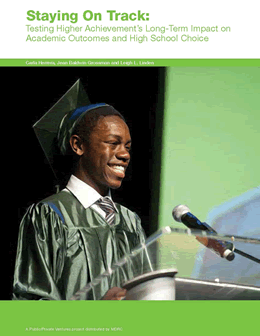Staying On Track: Testing Higher Achievement’s Long-Term Impact on Academic Outcomes and High School Choice

The middle school years are a critical period in youth’s academic lives, and for those who fall off track — especially in poor communities — it can be extremely difficult to get back on a steady path. How well students do in middle school, how smoothly they make the transition to high school, and what kind of high school they choose to attend can have profound implications for their future.
The Washington, DC-based Higher Achievement program works with motivated, disadvantaged youth throughout the middle school years, providing intensive academic instruction and other enrichment activities after school and over the summer. It aims to strengthen youth’s academic skills, attitudes, and behaviors and help them navigate the process of preparing for, applying to, and selecting a high-quality high school that can ultimately launch them toward college and careers.
In 2006, Public/Private Ventures, in partnership with Leigh Linden, began a comprehensive multiyear evaluation of Higher Achievement’s impact. This brief, distributed by MDRC, summarizes findings from the four-year random assignment study, which involved 952 youth. Comparing the outcomes and experiences of youth who had access to Higher Achievement (i.e., the treatment group) with those of a similar group of youth who did not have access to the program (i.e., the control group), the researchers found that:
- Higher Achievement fostered improvements in both math and reading comprehension, as measured by standardized tests. However, these changes took more than a year to materialize, and only the math impacts were sustained four years after youth enrolled in the program.
- The size of the gains was substantial relative to those yielded in other studies of out-of-school-time (OST) programs and year-to-year gains typically seen in middle school, yet not as large as those seen in some more expensive, comprehensive whole-school reforms.
- Higher Achievement boosted the odds that youth would apply to, be admitted to, and attend a private high school. And the program successfully steered youth away from weaker public magnet and charter schools.
To understand more about how Higher Achievement may have produced these benefits, the researchers examined a number of potential contributing factors. They found that Higher Achievement affected the types of academic and enrichment activities youth engaged in and the extent to which youth engaged in these activities with adults; youth’s academic attitudes and behaviors; the high school-related activities youth engaged in; and the extent to which youth’s parents participated in the high school application process. Higher Achievement did not appear to affect youth’s learning over the course of the summer; the types of peers youth spent time with; the amount of adult support they experienced; or youth’s reported criteria for selecting a high school.
These findings suggest that intensive OST programs like Higher Achievement can produce important benefits for middle school youth and may help keep them on a positive path well into the future. They also highlight some of the factors that other programs might consider trying to influence as they work to increase their impact on youth’s lives.







